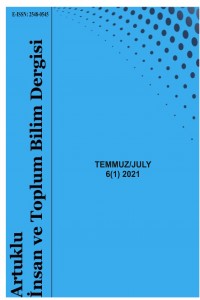Abstract
Tarih boyunca, özellikle erkekler arasında yaşanan aynı cinsiyetten ilişkiler her zaman tartışmalı bir konu olmuştur. Nitekim, eşcinselliğe karşı hoşgörüsüzlük, korku, nefret veya önyargı, ‘homofobi’ olarak adlandırılır. Geleneksel cinsiyet normlarına uymayan kişiler genellikle homofobik kişiler tarafından ayrımcılığa ve tacize uğrar. Dahası, homofobi şiddete yol açabilir ve tarihte de görüldüğü gibi eşcinsellikle suçlananları darağacına bile gönderebilir. Erken Modern Çağ'a doğru, eşcinsel davranışa karşı olan hoşgörüsüzlük özellikle soylular ve din adamları arasında topluma iyi birer örnek olmaları beklendiğinden ötürü büyüdü. Marlowe’un Edward II adlı oyunu ile Waterford ve Lismore Piskoposu John Atherton’ın ölümünden sonra yazılmış olan The Life and Death of John Atherton adlı anonim risale, Erken Modern Dönem İngilteresinde erkek eşcinselliği ve homofobiyi ele alır. Bu çalışmada, bahsi geçen bu iki eser detaylı bir biçimde incelenerek Erken Modern Dönem İngilteresinde erkek eşcinselliğine karşı görülen homofobi ve altında yatan nedenlerin tespit edilmesi hedeflenmektedir.
References
- Andersen, E. (Erişim Tarihi: 04.01.2021). Homophobia. (https://www.britannica.com/topic/homophobia).
- Bernard, N. (1651). The Penitent Death of a Woefull Sinner, or, The Penitent Death of Jo. Atherton Late Bishop of Waterford in Ireland. London: R. Ibbitson.
- Bray, A. (1994). Homosexuality and the Signs of Male Friendship in Elizabethan England. Queering the Renaissance (ed. Jonathan Goldberg). Durham and London: Duke University Press, p. 40-61.
- Bray, A. (1995). Homosexuality in Renaissance England. New York: Columbia University Press.
- DiGangi, M. (1997). The Homoerotics of Early Modern Drama. Cambridge: Cambridge University Press.
- King, J. (1710). The Case of John Atherton, Bishop of Waterford in Ireland: Fairly Represented. London: Luke Stokoe.
- Linkinen, T. (2015). Same-sex Sexuality in Later Medieval English Culture. Amsterdam: Amsterdam University Press.
- Marlowe, C. (1997). Edward the Second (eds. Martin Wiggins, and Robert Lindsey). London: A. & C. Black.
- Nissinen, M. (1998). Homoeroticism in the Biblical World: A Historical Perspective. Minneapolis, Minn.: Fortress Press.
- Norton, R. (Ed.), (Erişim Tarihi 10.01.2021) "The Life and Death of John Atherton, 1641", Homosexuality in Eighteenth-Century England: A Sourcebook. (http://www.rictornorton.co.uk/eighteen/atherton.htm).
- Sedgwick, E. K. (1985). Between Men: English Literature and Male Homosocial Desire. New York; Guildford: Columbia University Press.
- Shepherd, S. (1986). Marlowe and the Politics of Elizabethan Theatre. Brighton: Harvester.
- Sinfield, A. (1998). Gay and After. London: Serpent's Tail.
- Woods, G. (1992). Body, Costume, and Desire in Christopher Marlowe. Homosexuality in Renaissance and Enlightenment England: Literary Representations in Historical Context (ed. Claude J. Summers). New York; London: Haworth Press.
- Smith, B. R. (1991). Homosexual Desire in Shakespeare's England: A Cultural Poetics. Chicago; London: University of Chicago Press.
- Winnett, A. R. (1988). The Strange Case of Bishop John Atherton. Old Waterford Society DECIES, No. XXXIX, Autumn 1988, p. 4-18.
Abstract
Same sex relationships, especially among males, have always been a controversial issue throughout the history. The intolerance, fear, hatred of, or prejudice against homosexuality is called ‘homophobia’, which has long existed side by side with homosexuality. People who do not follow conventional gender norms usually experience discrimination and harassment by homophobic people. Furthermore, homophobia could lead to violence, and as is seen in the history, it could even send those who are accused of sodomy and/or buggery, the terms that were used to refer same sex relationships, to the gallows, as well. Towards the Early Modern Era, the intolerance of homosexual behaviour grew particularly among the aristocracy and the clergy for they were expected to set good example to the society. Marlowe’s Edward II, and The Life and Death of John Atherton, the anonymous pamphlet about Lord Bishop of Waterford and Lismore are two literary works which deal with male homosexuality and homophobia in the Early Modern England. This article aims to examine the specific homophobic behaviour towards male homosexuality with its real motives in the Early Modern England with a deeper look into these two works.
References
- Andersen, E. (Erişim Tarihi: 04.01.2021). Homophobia. (https://www.britannica.com/topic/homophobia).
- Bernard, N. (1651). The Penitent Death of a Woefull Sinner, or, The Penitent Death of Jo. Atherton Late Bishop of Waterford in Ireland. London: R. Ibbitson.
- Bray, A. (1994). Homosexuality and the Signs of Male Friendship in Elizabethan England. Queering the Renaissance (ed. Jonathan Goldberg). Durham and London: Duke University Press, p. 40-61.
- Bray, A. (1995). Homosexuality in Renaissance England. New York: Columbia University Press.
- DiGangi, M. (1997). The Homoerotics of Early Modern Drama. Cambridge: Cambridge University Press.
- King, J. (1710). The Case of John Atherton, Bishop of Waterford in Ireland: Fairly Represented. London: Luke Stokoe.
- Linkinen, T. (2015). Same-sex Sexuality in Later Medieval English Culture. Amsterdam: Amsterdam University Press.
- Marlowe, C. (1997). Edward the Second (eds. Martin Wiggins, and Robert Lindsey). London: A. & C. Black.
- Nissinen, M. (1998). Homoeroticism in the Biblical World: A Historical Perspective. Minneapolis, Minn.: Fortress Press.
- Norton, R. (Ed.), (Erişim Tarihi 10.01.2021) "The Life and Death of John Atherton, 1641", Homosexuality in Eighteenth-Century England: A Sourcebook. (http://www.rictornorton.co.uk/eighteen/atherton.htm).
- Sedgwick, E. K. (1985). Between Men: English Literature and Male Homosocial Desire. New York; Guildford: Columbia University Press.
- Shepherd, S. (1986). Marlowe and the Politics of Elizabethan Theatre. Brighton: Harvester.
- Sinfield, A. (1998). Gay and After. London: Serpent's Tail.
- Woods, G. (1992). Body, Costume, and Desire in Christopher Marlowe. Homosexuality in Renaissance and Enlightenment England: Literary Representations in Historical Context (ed. Claude J. Summers). New York; London: Haworth Press.
- Smith, B. R. (1991). Homosexual Desire in Shakespeare's England: A Cultural Poetics. Chicago; London: University of Chicago Press.
- Winnett, A. R. (1988). The Strange Case of Bishop John Atherton. Old Waterford Society DECIES, No. XXXIX, Autumn 1988, p. 4-18.
Details
| Primary Language | English |
|---|---|
| Journal Section | Article/Book Translation |
| Authors | |
| Publication Date | July 14, 2021 |
| Published in Issue | Year 2021 Volume: 1 Issue: 6 |


